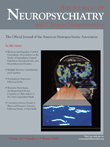Clinical Correlates of Personality Changes Associated With Traumatic Brain Injury
To the Editor: Traumatic brain injury (TBI) is frequently complicated by alterations in temperament and character that have adverse consequences for day-to-day living, manifesting as poor decision-making, interpersonal problems, communication problems, and often overall poor quality of life. 1 Max et al. 2 have reported extensively on the correlates and predictors of personality changes after traumatic brain injury in children, but there is scant mention in the literature on adults. In this report, we describe the results of a preliminary study of the clinical correlates of personality change following traumatic brain injury in adults.
Analysis
Data are from a retrospective chart review of 54 subjects with closed head injury enrolled in an outpatient neuropsychiatry brain injury clinic. Patients with depressed skull fractures were excluded.
Every patient was evaluated and followed by a clinic psychiatrist. The assignment of personality change due to a general medical condition (TBI) diagnosis was based on DSM-IV criteria. Pharmacological treatment was the primary mode of management. If records indicated that a patient had returned to “baseline,” or had improvement in more than half the number of presenting symptoms, that patient was considered a “treatment responder.” A patient who had absent or minimal improvement in symptoms was considered a “nonresponder.”
About a third of the sample (n=17, 32%) was diagnosed with personality changes.
The mean age of the sample was 41.1 years (SD=12.26; range=18–69). Most patients were male (N=37, 68.5%), and 81.5% were Caucasians. The mean level of education was 13.4 years (range=8–20). Forty-four percent of the patients had suffered mild traumatic brain injury, 20.4% moderate injury, and 35.2% had a severe injury, based on the Glasgow Coma Scale (GCS) scores at the time of the injury. Those with personality change were compared to those without personality change. The two groups did not differ in number of injuries, type of trauma, age, education, pre-traumatic brain injury marital, employment and legal status, substance abuse, and/or pre-traumatic brain injury history of mood disorder. However, those with personality change were disproportionately non-Caucasians, had lower scores on the Mini-Mental State Exam (MMSE), had more severe traumatic brain injury, were less likely to be employed post-TBI, and were more frequently judged to have failed pharmacologic treatment.
Discussion
In this study personality changes are associated primarily with severe traumatic brain injury, as was the case in an earlier study. 3 Association between personality change and mild traumatic brain injury has also been reported. 4 We are not surprised that our patients who had personality change did not benefit from pharmacological treatment since it is well established that multimodal regimens that include medications and psychotherapy are the best. 5 Our patients with personality change had worse cognitive function and were less successful in finding employment after traumatic brain injury but did not have a higher rate of substance abuse, legal problems, or mood disorder as has been reported by others. 4 , 6
Conclusion
Our investigation relied on a highly selected sample and was limited in scope by the source of the data and the size of the sample. However, these observations are still helpful for guiding the development of future prospective studies.
1 . Warriner EM, Velikonja D: Psychiatric disturbances after traumatic brain injury: neurobehavioral and personality changes. Curr Psychiatry Rep 2006; 8:73–80Google Scholar
2 . Max JE, Levin HS, Schachar RJ, et al: Predictors of personality change due to traumatic brain injury in children and adolescents six to twenty-four months after injury. J Neuropsychiatry Clin Neurosci 2006; 18:21–32Google Scholar
3 . Golden Z, Golden CJ: Impact of brain injury severity on personality dysfunction. Int J Neurosci 2003; 113:733–745Google Scholar
4 . Miller LJ, Donders J: Subjective symptomatology after traumatic head injury. Brain Inj 2001; 15:297–304Google Scholar
5 . Prigatano GP, Klonoff PS, O’Brien KP, et al: Productivity after neuropsychologically oriented milieu rehabilitation. J Head Trauma Rehabil 1994; 9:91–102Google Scholar
6 . Tateno A, Jorge RE, Robinson RG: Clinical correlates of aggressive behavior after traumatic brain injury. J Neuropsychiatry Clin Neurosci 2003; 15:155–160Google Scholar



